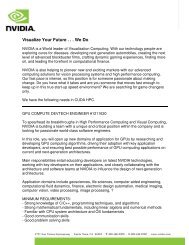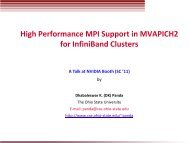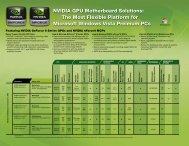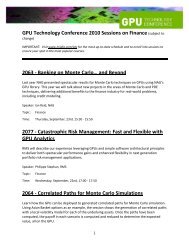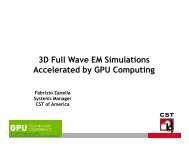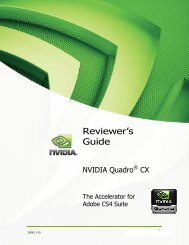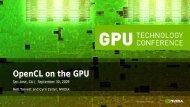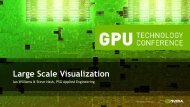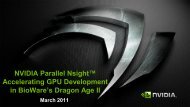NVIDIA QUADRO G-SYNC II
NVIDIA QUADRO G-SYNC II
NVIDIA QUADRO G-SYNC II
Create successful ePaper yourself
Turn your PDF publications into a flip-book with our unique Google optimized e-Paper software.
Confi guring Swap Barriers<br />
You can bind a group to a barrier. There is a maximum<br />
number of barriers that can be created. With the current<br />
hardware, the maximum number of barriers is one.<br />
� To determine the maximum barrier number, call<br />
QueryMaxSwapGroupsNV()<br />
� To bind a group to a barrier, call<br />
BindSwapBarrierNV()<br />
and specify the group and barrier numbers.<br />
If the barrier number is zero, then the group in unbound from the<br />
current barrier.<br />
To query the current barrier, call QuerySwapGroupNV().<br />
OpenGL Extensions<br />
This section describes the relevant OpenGL NV_swap_<br />
group extensions supported by the <strong>NVIDIA</strong> display driver<br />
and shipped with the Quadro G-Sync <strong>II</strong> hardware.<br />
These are exported in the WGL extension string which on<br />
Windows can be queried by wglGetExtensionsStringARB.<br />
This section covers both the WGL_NV_swap_group extensions<br />
(exported on Microsoft WindowsNT/XP systems) and the GLX_<br />
NV_swap_group extensions (exported on Linux systems).<br />
� wglJoinSwapGroupNV(), glxJoinSwapGroupNV()<br />
Using the OpenGL Extensions<br />
� wglBindSwapBarrierNV(), glxBindSwapBarrierNV()<br />
� wglQuerySwapGroupNV(), glxQuerySwapGroupNV()<br />
� wglQueryMaxSwapGroupsNV(), glxQueryMaxSwapGroupsNV()<br />
� wglQueryFrameCountNV(),glxQueryFrameCountNV()<br />
� wglResetFrameCountNV(),glxResetFrameCountNV()<br />
60




